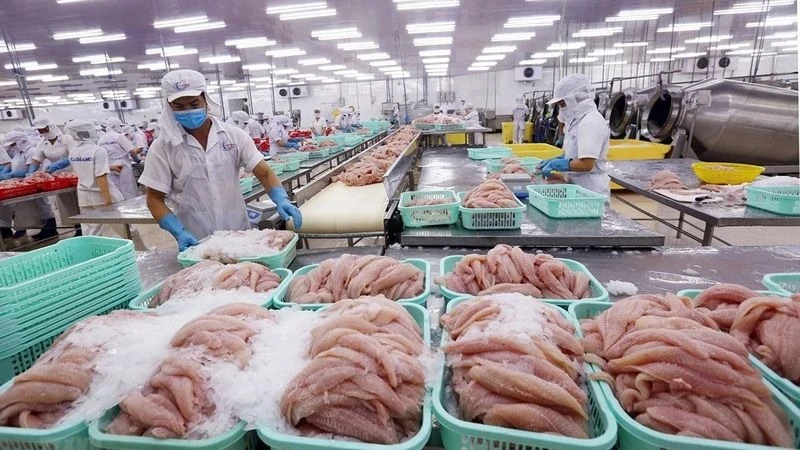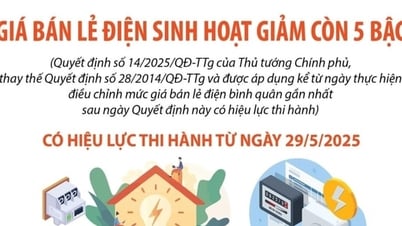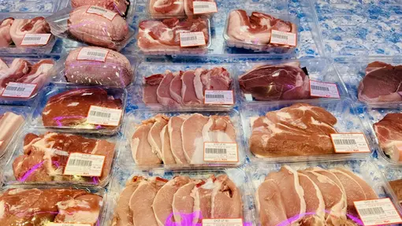In the first 4 months of 2025, Vietnam's seafood export turnover reached 3.3 billion USD, up 21% over the same period last year.
Recorded growth in many seafood products
According to the report of the Vietnam Association of Seafood Exporters and Producers, seafood exports in the first 4 months of 2025 recorded a strong recovery, reaching a turnover of 3.3 billion USD, an increase of 21% over the same period in 2024. In April 2025 alone, the export turnover reached 850.5 million USD, an increase of 10%. However, the export picture is uneven between products and markets, in the context of the instability of reciprocal tariffs from the US, which is creating many challenges.
Shrimp continued to be the main commodity, contributing 1.27 billion USD in the first 4 months of the year, up 30% over the same period. In April alone, shrimp exports reached 330.8 million USD, up 15%. This growth came from strong demand in major markets such as China, the EU and Japan, along with shrimp prices gradually recovering due to the rebalancing of global supply and demand. Pangasius, with a turnover of 632.7 million USD (up 9%), maintained its important position but growth slowed down, especially in April, reaching only 167.7 million USD, no increase over the same period.
Tuna recorded a decline in April (USD 76.1 million, down 12%), although the cumulative 4 months still increased slightly by 1% (USD 304.2 million). Raw material shortages, especially due to the minimum size regulation for skipjack tuna, have limited production and exports. In contrast, items such as tilapia and red tilapia grew dramatically (138%, reaching USD 19 million), although their contribution was still small. Mollusks (cephalopods, shell) and crabs also recorded impressive growth, reaching USD 216.4 million (up 18%), USD 83.1 million (up 82%) and USD 112.1 million (up 50%), respectively, thanks to high demand from China and ASEAN.
Exports to US fall in April due to tariff disruption
According to the Vietnam Association of Seafood Exporters and Producers (VASEP), China is the leading market, reaching 709.8 million USD in 4 months, up 56%. April recorded 182.3 million USD, up 29%, mainly due to demand for shrimp, crab and molluscs serving the high-end segment. Japan ranked second with 536.6 million USD (up 22%), growing steadily thanks to value-added products. The EU and South Korea also showed potential with turnover of 351.5 million USD (up 17%) and 264.1 million USD (up 15%), respectively, especially thanks to preferential tariff policies from EVFTA.
However, the US market only reached 498.4 million USD (up 7%), with April down 15% (120.5 million USD). This decline reflects the impact of the current reciprocal tariff policy from the US, disrupting export activities. ASEAN was a bright spot with 218.8 million USD (up 25%), while the Middle East decreased 8% due to low consumption demand.
The US’s reciprocal tariff policy, with high anti-dumping duties (up to 46% for some products), is putting great pressure on Vietnam’s seafood exports. Products such as pangasius and shrimp, which are heavily dependent on this market, are heavily affected. Tariffs increase product costs, causing US importers to consider switching to other sources of supply such as India or Ecuador. Technical barriers, such as food safety testing and strict traceability requirements, also reduce Vietnam’s competitive advantage.
However, the CPTPP and other FTAs are helping Vietnam mitigate the negative impacts by expanding its markets to the EU, Japan and ASEAN. Vietnamese businesses are also adjusting their strategies, focusing on value-added products and diversifying their markets to reduce their dependence on the US.
VASEP also forecasts that in May and June 2025, Vietnam's seafood exports will see a strong shift before the new US reciprocal tariff policy takes effect from July 9, 2025. Vietnamese businesses will focus on boosting exports to the US, especially key products such as shrimp and pangasius, to make the most of the period before new tariffs increase costs. It is expected that export turnover to this market may increase by 10-15% compared to April 2025, thanks to hastily signed contracts and a price reduction strategy to maintain market share./.
According to Nhan Dan Newspaper
Source: https://nhandan.vn/xuat-khau-thuy-san-viet-nam-phuc-hoi-manh-me-post877654.html
Source: https://baolongan.vn/xuat-khau-thuy-san-viet-nam-phuc-hoi-manh-me-a194745.html






![[Photo] Crane falls on container truck and car at traffic construction site](https://vphoto.vietnam.vn/thumb/1200x675/vietnam/resource/IMAGE/2025/5/31/a8d3ae08da324cfe8ee406174c0eacc4)


























































































Comment (0)